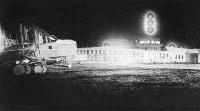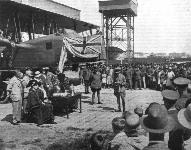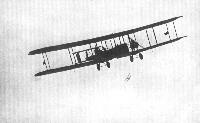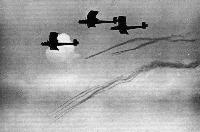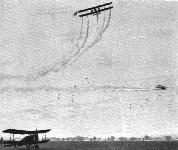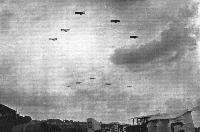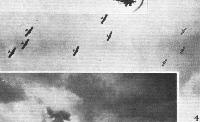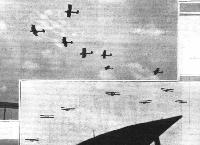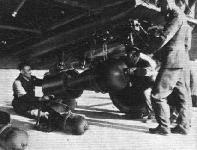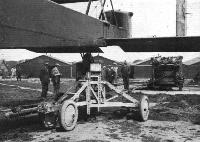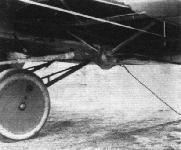
Vickers Type 57 Virginia
Прототип довольно большого биплана Type 57 Virginia, мало отличавшегося по конструкции от Vimy, совершил первый полет 24 ноября 1922 года. Этот самолет стал основой сил тяжелых ночных бомбардировщиков Королевских ВВС Великобритании (RAF) в годы между двумя мировыми войнами. Virginia несли службу в боевых частях с 1924 года до середины 1930-х годов, а затем использовались для подготовки парашютистов на авиабазе Хенлоу. Ко времени завершения производства ВВС получили 124 самолета.
Первым из 10 вариантов стал опытный Virginia Mk I, оснащенный парой ПД Napier Lion по 450 л. с. (336 кВт), которые позднее заменили на 650-сильные (485 кВт) ПД Rolls-Royce Condor III, присвоив новое обозначение Type 96 Virginia Mk I.
В дальнейшем самолет получил новый удлиненный фюзеляж с доработанной носовой частью, стрелковые точки на задних частях крыла и сменил обозначение на Type 115 Virginia Mk VIII. Позднее самолет прошел доработку до стандарта Type 129 Virginia Mk VII и, наконец, до Virginia Mk X.
Второй прототип, Type 76 Virginia Mk II, отличался двигателями Napier Lion и удлиненной носовой частью, облегчавшей работу бомбардира. После испытаний эта машина, как и первый прототип, сначала была доработана до стандарта Mk VII, а затем и до стандарта Virginia Mk X.
Type 79 Virginia Mk III, построенный по контракту с Министерством авиации от 1922 года, был близок по конструкции Virginia Mk II, но имел сдвоенное управление, бомбодержатели под крылом и был оснащен двигателями Napier Lion II по 468 л. с. (349 кВт).
Практически идентичный Mk III, вариант Type 99 Virginia Mk IV получил дополнительное оборудование и увеличенную бомбовую нагрузку. Один из этих самолетов использовался для испытаний бипланного хвостового оперения с третьим (центральным) рулем направления.
Такое же оперение получил первый основной серийный вариант Type 100 Virginia Mk V (построено 22). Вариант Type 108 Virginia Mk VI (построено 25) получил доработанное крыло, и до этого стандарта доработали еще шесть Virginia Mk V.
Второй выпущенный Virginia Mk III был возвращен компании "Vickers" для установки новой носовой части, улучшавшей обзор пилота, одновременно получив все доработки, введенные на Mk VI, а также удлиненную заднюю часть фюзеляжа и небольшую стреловидность крыла для повышения устойчивости. В таком виде он послужил прототипом для варианта Type 112 Virginia Mk VII, построенного в количестве 11 машин. До этого стандарта доработали еще 38 самолетов ранних модификаций.
На Type 128 Virginia Mk IX (построено 8, доработано 27 самолетов) ввели автоматические предкрылки и хвостовую стрелковую точку, а последний вариант Type 139 Virginia Mk X (построено 50, доработано 53) получил цельнометаллический каркас.
Сыгравшие важную роль в становлении будущего Бомбардировочного командования, многие самолеты Virginia продолжали использоваться для различных экспериментов до 1941 года, в основном в качестве летающих лабораторий для испытаний двигателей.
ТАКТИКО-ТЕХНИЧЕСКИЕ ХАРАКТЕРИСТИКИ
Vickers Virginia Mk X
Тип: тяжелый ночной бомбардировщик-биплан
Силовая установка: два 12-цилиндровых ПД Napier Lion VB мощностью по 580 л. с. (433 кВт)
Летные характеристики: максимальная скорость на высоте 1525 м - 174 км/ч; потолок 4725 м; дальность полета 1585 км
Масса: пустого 4377 кг; максимальная взлетная 7983 кг
Размеры: размах крыла 26,72 м; длина 18,97 м; высота 5,54 м; площадь крыла 202,34 м2
Вооружение: один 7,7-мм пулемет Lewis в носовой части и сдвоенный Lewis в хвостовой, до 1361 кг бомб
- Описание
Фотографии
-
Air Enthusiast 1997-01 / J.Goulding - Enduring Nocturnal
Регистрационный номер: J6856 [10] Virginia I J6856. The engine nacelles on this aircraft differed from all other Virginias. J6856 was converted to Mk III status in late 1924.
-
Aeroplane Monthly 1993-06 / O.Thetford - By day and by night: Ginnies in service 1
Регистрационный номер: J7132 Virginia Mk III J7132 of 7 Sqn
-
Air Enthusiast 1997-01 / J.Goulding - Enduring Nocturnal
Регистрационный номер: J7275 [5] Virginia IV J7275. Issued initially to 7 Squadron in September 1924, it was retired from service (by then with the Royal Aircraft Establishment) in October 1935. The Mk IV was outwardly similar to the Mk III.
-
Aeroplane Monthly 1993-06 / O.Thetford - By day and by night: Ginnies in service 1
Регистрационный номер: J7434 Virginia Mk V J7434 of 9 Sqn
-
Air Enthusiast 1997-01 / J.Goulding - Enduring Nocturnal
Регистрационный номер: J7423 Virginia VI J7423 in NIVO finish. Built as a Mk V, it was converted to Mk VI status during late 1925 and went on to serve with 7 Squadron, 58 Squadron and 9 Squadron, retiring in August 1930.
-
Aeroplane Monthly 1993-06 / O.Thetford - By day and by night: Ginnies in service 1
Регистрационный номер: J7438 [4] Virginia Mk VI J7438 of 58 Sqn
-
Aeroplane Monthly 1993-06 / O.Thetford - By day and by night: Ginnies in service 1
Регистрационный номер: J8326 Virginia Mk VII J8326 of 7 Sqn
-
Air Enthusiast 1997-01 / J.Goulding - Enduring Nocturnal
Регистрационный номер: J8329 Virginia VII J8329 of ‘A’ Flight, 7 Squadron. Issued to the unit in June 1927, it was briefly away for tail modifications in early 1928 before rejoining. J8329 transferred to 58 Squadron in September 1928.
-
Aeroplane Monthly 1993-06 / O.Thetford - By day and by night: Ginnies in service 1
Регистрационный номер: K2330 Virginia Mk X K2330 of 500 Sqn
-
Air Enthusiast 1997-01 / J.Goulding - Enduring Nocturnal
Регистрационный номер: J7438 [4] Virginia X J7438 of 500 (County of Kent) Special Reserve Squadron. Built in 1925 as a Mk V, J7438 became, in sequence a Mk VI, VII and IX before being converted to a Mk X in early 1931 joining 500 Squadron in January 1934. It served with 58 Squadron from 1936 to 1938.
-
Air Enthusiast 1997-01 / J.Goulding - Enduring Nocturnal
Регистрационный номер: K2329 Virginia X K2329 of the Parachute Training Flight, Home Aircraft Depot, Henlow. The aircraft was one of four that took part in the last Hendon Air Pageant, 1937. Built in late 1931, it was resident at Henlow from 1932 until it was written off in a crash on take-off March 21,1940.
-
Aeroplane Monthly 1993-05 / P.Jarrett - By day and by night /The classic inter-war RAF biplane bombers/ (12)
Регистрационный номер: J6856 [10] The prototype Vickers Virginia long-distance bomber, two Napier "Lion" engines. It was first flown on November 24, 1922, from Brooklands by Capt Stan Cockerell.
-
Flight 1923-02 / Flight
Регистрационный номер: J6856 [10] THE VICKERS "VIRGINIA": These four views have been passed for publication by the Air Ministry, but no detail description may be given. The machine is fitted with two Napier "Lion" engines. The motor-car and men in the photographs give a good idea of the size of the machine.
-
Air Enthusiast 1997-01 / J.Goulding - Enduring Nocturnal
Регистрационный номер: J6856 [10] J6856, the first Virginia, just before the maiden flight. Note the small rudders, which gave a lack of directional control.
-
Aeroplane Monthly 1993-05 / P.Jarrett - By day and by night /The classic inter-war RAF biplane bombers/ (12)
Регистрационный номер: J6856 [10] The prototype again, with serial number J6856 painted on the fuselage and rudders. This photograph was probably taken at Martlesham Heath during the winter of 1922-23.
-
Air Enthusiast 1997-01 / J.Goulding - Enduring Nocturnal
Регистрационный номер: J6856 [10] J6856 fitted with fore-and-aft ‘fighting tops’.
-
Aeroplane Monthly 1993-05 / P.Jarrett - By day and by night /The classic inter-war RAF biplane bombers/ (12)
A Virginia Mk III fitted with two Napier Lions. This dual-control version had provision for a downward-firing gun in the front fuselage.
-
Air Enthusiast 1997-01 / J.Goulding - Enduring Nocturnal
Virginia 'Polaris' probably a Mk III of 7 Squadron.
-
Air Enthusiast 1997-01 / J.Goulding - Enduring Nocturnal
Регистрационный номер: J6993 The second Virginia III, J6993, as it appeared at the Hendon Air Pageant in June 1923. It was shown in the new types park as No 7.
-
Air Enthusiast 1997-01 / J.Goulding - Enduring Nocturnal
Регистрационный номер: J7275 [5] J7275 the second Mk IV and generally similar to the Mk III.
-
Aeroplane Monthly 1982-07 / P.Capon - Capon's Corner
Регистрационный номер: J7246 Visiting Stag Lane also in 1925 was this Vickers Virginia V heavy night bomber. The type entered service with the RAF in 1924, with Nos 7 and 58 Sqns. J7426 is painted in standard dark green night bomber camouflage
-
Air Enthusiast 1997-01 / J.Goulding - Enduring Nocturnal
Virginia V identified by the third rudder and NIVO paint scheme.
-
Aeroplane Monthly 1993-05 / P.Jarrett - By day and by night /The classic inter-war RAF biplane bombers/ (12)
This Virginia, possibly a Mk V, has a flat upper wing and 4° dihedral on the bottom wing only.
-
Air Enthusiast 1997-01 / J.Goulding - Enduring Nocturnal
Регистрационный номер: J7425 The Mk VI prototype, J7425, was originally built as a Mk V production aircraft.
-
Aeroplane Monthly 1993-05 / P.Jarrett - By day and by night /The classic inter-war RAF biplane bombers/ (12)
The Virginia VI - note equal dihedral but no sweepback on the wings.
-
Air Enthusiast 1997-01 / J.Goulding - Enduring Nocturnal
Virginia VI, the equal dihedral on the wings is evident.
-
Air Enthusiast 1997-01 / J.Goulding - Enduring Nocturnal
Регистрационный номер: J7438 [4] Mk VI J7438 outside the hangars at Brooklands.
-
Air Enthusiast 1997-01 / J.Goulding - Enduring Nocturnal
A Mk VII attached to a wheeled tail trolley for ease of ground handling. The short nose of this version is apparent.
-
Aeroplane Monthly 1993-05 / P.Jarrett - By day and by night /The classic inter-war RAF biplane bombers/ (12)
Регистрационный номер: J7427 J7427, built as a Virginia Mk V, after conversion to Mk VII with lengthened fuselage, sweptback wings and reprofiled front fuselage.
-
Air Enthusiast 1997-01 / J.Goulding - Enduring Nocturnal
Регистрационный номер: J6856 [10] J6856 the first Virginia converted into a Mk VII, with ‘fighting tops’ for rear defence.
-
Air Enthusiast 1997-01 / J.Goulding - Enduring Nocturnal
Регистрационный номер: J6856 [10] Virginia VIIs of 7 Squadron, note J6856 with ‘fighting tops’ second from right.
-
Air Enthusiast 1997-01 / J.Goulding - Enduring Nocturnal
Регистрационный номер: J6856 [10] Another view of J6856, taken during 1927, during trials with 7 Squadron. The gunners are demonstrating the route to the ‘fighting tops’.
-
Air Enthusiast 1997-01 / J.Goulding - Enduring Nocturnal
Mk VIII of 7 Squadron ‘B’ Flight.
-
Aeroplane Monthly 1993-05 / P.Jarrett - By day and by night /The classic inter-war RAF biplane bombers/ (12)
Регистрационный номер: J6856 [10] The sole Virginia Mk VIII, J6856, fitted with Rolls-Royce Condors and “fighting tops” on the wing trailing edge only.
-
Air Enthusiast 1997-01 / J.Goulding - Enduring Nocturnal
Регистрационный номер: J7715 [2] Mk IX J7715 carrying a full under wing load of eight bombs - nine more could be carried internally.
-
Aeroplane Monthly 1993-05 / P.Jarrett - By day and by night /The classic inter-war RAF biplane bombers/ (12)
Регистрационный номер: J7715 [2] Virginia IX J7715, showing the newly-introduced tail turret.
-
Aeroplane Monthly 1993-06 / O.Thetford - By day and by night: Ginnies in service 1
Регистрационный номер: J7716 Virginia IX J7716 flew with Nos 7, 58 and 9 Sqns and was originally built as a Mk VI.
-
Air Enthusiast 1997-01 / J.Goulding - Enduring Nocturnal
Регистрационный номер: J8236 [2] Trials underway using Virginia IX J8236 into the use of land catapults for launching heavily-laden bombers.
-
Aeroplane Monthly 1993-05 / P.Jarrett - By day and by night /The classic inter-war RAF biplane bombers/ (12)
Регистрационный номер: J8236 [2] Первый британский стратегический бомбардировщик межвоенного периода Vickers Virginia состоял на вооружении с 1924 до 1937 года. На снимке: версия Mk VII, такие машины служили в 58-й эскадрилье, которой Харрис командовал в 1925 году.
Virginia IX J8236, fitted with geared Gnome-Rhone Jupiter engines, July 1928. Built originally as a Mk VII, this aircraft was later used for catapult trials with winch accelerator, and for locust spraying! -
Aeroplane Monthly 1993-05 / P.Jarrett - By day and by night /The classic inter-war RAF biplane bombers/ (12)
Регистрационный номер: J7130 [2] Vickers Virginia X J7130 fitted with Bristol Pegasus radials, circa 1934. Note the automatic slats fitted to the wings.
-
Air Enthusiast 1997-01 / J.Goulding - Enduring Nocturnal
Регистрационный номер: J7130 [2] Mk X J7130, used for Bristol Pegasus engine testing, probably in connection with the Vickers Valentia.
-
Aeroplane Monthly 1993-06 / O.Thetford - By day and by night: Ginnies in service 1
Регистрационный номер: J7711 Virginia X J7711 of 9 Sqn. In mid-1934 it passed to 500 Sqn.
-
Air Enthusiast 1997-01 / J.Goulding - Enduring Nocturnal
Mk X ‘Isle of Thanet’ of 500 (Kent) Squadron at Mauston.
-
Flight 1928-07 / Flight
SLOTTED WINGS: Two views of the Vickers "Virginia" bomber fitted with the Handley-Page slotted wings. On the left, the slots are shown closed, and on the right, open.
-
Aeroplane Monthly 1993-06 / O.Thetford - By day and by night: Ginnies in service 1
A LINE-UP: Six Vickers "Virginia" night bombers (twin Napier "Lions") of No. 502 (Ulster) (Bomber) Squadron at Aldergrove Aerodrome.
An impressive line-up of Virginia Xs of 502 (Ulster) Squadron at RAF Aldergrove in November 1933. -
Flight 1924-07 / Flight
AT THE R.A.F. PAGEANT: One of the larger machines which took part in the "Fly Past": The Handley Page "Hyderabad" and the Vickers "Virginia," twin-engined (Napier "Lions") bombers.
Другие самолёты на фотографии: Handley Page Hyderabad/H.P.24 / Hinaidi/H.P.33 / Clive/H.P.35 - Великобритания - 1923
-
Flight 1927-09 / Flight
Hooton Air Pageant: This Vickers "Virginia" was very useful to many spectators for sheltering from the incessant rain that tried its hardest to wash out the Pageant, but failed.
-
Air International 1983-11
With parachutist on the port wing, a Virginia taxies out at one of the pre-war RAF Displays at Hendon.
-
Air Enthusiast 1997-01 / J.Goulding - Enduring Nocturnal
An atmospheric view of a Virginia X warming up its Lion engines at night on April 7, 1932 at RAF Worthy Down, the home of Nos 7 and 5 Sqn’s Virginias, showing excellent detail of the engine installation, radiators, undercarriage and flares under the wing.
-
Flight 1931-09 / Flight
A view of the Control Tower at Croydon lit by their own floodlight. The aircraft on the left are the two Vickers "Virginia" night-bombers.
-
Flight 1931-06 / Flight
No. 500 (County of Kent) (Bomber) Squadron. The first "Virginia" of the new Cadre Squadron at Manston was christened "Isle of Thanet" by the Mayors of Margate and Ramsgate on June 4.
-
Flight 1930-10 / Flight
Mr. Scullin inspects the Vickers "Virginia" Mark X.
-
Air Enthusiast 1997-01 / J.Goulding - Enduring Nocturnal
Virginia X ‘Aries’ showing front fuselage detail.
-
Flight 1933-11 / Flight
THE SPECIAL RESERVE FLIGHT: Names, left to right: (in pilot's cockpit) Flt. Lt. R. C. Newton, S.R., and F/O. C. W. Lindsay, S.R.; (on ground) Flt. Lt. H. K. Goode, D.S.O., D.F.C., Adjt.; Wing Com. L. T. N. Gould, M.C., Commanding Officer; Flt. Lt. J. H. Sender; P/O. R. T. Corry, S.R.; F/O. J. K. Brew; P/O. B. G. Corry, S.R.; P/O. F. F. Rainsford, S.R.; P/O. J. L. C. Newton, S.R., and P/O. J. A. Robinson, S.R.
-
Aeroplane Monthly 1993-07 / O.Thetford - By day and by night: Ginnies in service 2
Men and machine of 9 Sqn, probably at either RAF Mansion or Boscombe Down, homes of the squadron’s Virginias during the late Twenties and early Thirties. The Virginia is J8912, which spent its entire service with 9 Sqn.
-
Air-Britain Aeromilitaria 1981-02
Mr. D.R.Neate has kindly provided these photographs of Manston and No.500 Squadron's Virginias.
-
Flight 1932-06 / Flight
Officers and Pilots of No. 7 B.S. with the Minor Trophy.
-
Flight 1932-06 / Flight
Officers and Pilots of No. 58 B.S.
-
Flight 1932-06 / Flight
Vickers Virginia Mark X
-
Aeroplane Monthly 1993-06 / O.Thetford - By day and by night: Ginnies in service 1
Регистрационный номер: K2676 Virginia Xs of 58 Sqn, with K2676 in the foreground. It was finally struck off RAF charge in 1938.
-
Aeroplane Monthly 1979-02 / F.Adkin - Memoirs of Aircraftsman (2)
The Vickers Virginia was produced in wood and metal.
-
Flight 1931-07 / Flight
CATAPULTED: A "VIRGINIA" NIGHT-BOMBER IS SHOT INTO THE AIR BY A 4,000 H.P. ENGINE AFTER A 100 FEET RUN.
-
Aeroplane Monthly 1993-05 / P.Jarrett - By day and by night /The classic inter-war RAF biplane bombers/ (12)
A 9 Sqn Vickers Virginia X in the circuit at RAF Hendon at the time of the 1935 RAF Pageant in July. The squadron took delivery of its Mk Xs in May 1930, and by May 1936 they had been phased out and replaced by Heyford IIIs.
-
Air Enthusiast 1997-01 / J.Goulding - Enduring Nocturnal
Mk X of 9 Squadron on its way to the RAF Pageant at Hendon, 1935.
-
Aeroplane Monthly 1993-06 / O.Thetford - By day and by night: Ginnies in service 1
Регистрационный номер: J7438 [4] Virginia J7438 of 500 Sqn was built as a Mk V, became a VI in 1925, a Mk VII in 1927, a Mk IX later the same year and in 1930 was upgraded to Mk X.
-
Aeroplane Monthly 1997-12 / G.Tuff - A life in service
Vickers Virginia J743? of 500 (County of Kent) Bomber Squadron. These were being replaced by Hawker Hart variants when the author joined the unit.
-
Flight 1935-06 / Flight
The faithful "Virginia" is a heavy bomber with two water-cooled "Lions.'' The type is being replaced.
-
Flight 1934-05 / Flight
HOOKED! There is a certain grotesquely helpless appearance about this aircraftsman as he is jerked off the wing of the Vickers "Virginia" during practice near Henlow.
-
Aeroplane Monthly 1993-07 / O.Thetford - By day and by night: Ginnies in service 2
RAF airmen being trained in the use of parachutes by means of the "pull-off" method at RAF Henlow. The pupil stood on the little platform at the base of outer rear interplane strut, pulled his ripcord and the opening parachute carried him away from the machine - provided he let go of the strut!
-
Air Enthusiast 1997-01 / J.Goulding - Enduring Nocturnal
Mk X of the Home Aircraft Depot, Henlow. A parachutist has just been pulled off, while another awaits his turn on the starboard side.
-
Air Enthusiast 1997-01 / J.Goulding - Enduring Nocturnal
Two parachutists are pulled from a Mk X.
-
Мировая Авиация 248
В ранний межвоенный период самолет Virginia был основным тяжелым бомбардировщиком британских ВВС. Вариант Mk X состоял на вооружении 7-й, 9-й, 10-й, 51-й, 58-й, 214-й, 215-й, 500-й и 502-й бомбардировочных эскадрилий до конца 1927 года.
-
Flight 1926-05 / Flight
"F.F.V.": A Vickers "Virginia" surveys Central London during the Great Strike.
Vickers "Virginia" (Two Napier "Lions") It is now six years since the late Sir John Alcock and Sir Arthur Whitten Brown flew across the Atlantic in a Vickers "Vimy" with two Rolls-Royce "Eagle" engines, a type similar to that on which the late Sir Ross Smith, and his brother, Sir Keith Smith, flew from London to Australia. The "Vimy" may be said to have been the prototype of the Vickers "Virginia" four-seater long-distance bomber which will take part in the Display. The "Virginia" is, however, fitted with more powerful engines (Napier "Lions"). The "Virginia" forms the standard equipment of Bombing Squadrons No.7, Bircham Newton, 9 (Manston), and 58 (Worthy Down). -
Air Enthusiast 1997-01 / J.Goulding - Enduring Nocturnal
Mk X, probably of 58 Squadron.
An evocative view of a Virginia X under full sail. The 87ft 8in-span bomber normally carried a pilot, navigator and two gunners. Two 580 h.p. Napier Lion VBs gave the biplane a maximum speed of 108 m.p.h. at 5,000ft and a ceiling of 15,530ft. -
Flight 1932-06 / Flight
Over the bombing target. Night bombers do not bomb from such a low altitude but no picture could be made from their normal height.
-
Air-Britain Aeromilitaria 1981-02
Mr. D.R.Neate has kindly provided these photographs of Manston and No.500 Squadron's Virginias. Here is 'Isle of Thanet', coded A and whose serial we have yet to disinter.
-
Air-Britain Aeromilitaria 1981-02
Регистрационный номер: J7566 Mr. D.R.Neate has kindly provided these photographs of Manston and No.500 Squadron's Virginias. Aircraft B 'City of Canterbury' was J7566 and is shown here.
-
Flight 1934-07 / Flight
AERIAL SKITTLES: An amusing and original event was that in which Vickers "Virginia" bombers of No. 99 (Bomber) Squadron flew low over a row of big skittles and endeavoured to "bowl" them over with their bombs. Here we see what was almost a direct hit.
-
Aeroplane Monthly 1993-07 / O.Thetford - By day and by night: Ginnies in service 2
An evocative photograph of Virginias parachute training, presumably at RAF Henlow. One wonders what the chap with the Lewis gun mounted on the tender is potting at; not, hopefully, drifting parachutists.
-
Flight 1928-06 / Flight
VICKERS "VIRGINIA": Night Bomber, with two Napier "Lion" Engines.
A "Virginia " stunting, while under it and in the background may be seen a "Gloster Gamecock."Другие самолёты на фотографии: Gloster Gamecock - Великобритания - 1925
-
Jane's All the World Aircraft 1980 / Encyclopedia of Aviation - Aircraft A-Z - v5
Vickers Virginia bombers.
-
Air Enthusiast 1997-01 / J.Goulding - Enduring Nocturnal
Four Virginias in loose formation - possibly reflecting the unstable characteristics of the early versions!
-
Aeroplane Monthly 1993-06 / O.Thetford - By day and by night: Ginnies in service 1
A loose formation of Virginia Xs on exercise. By the time Virginia production ceased in December 1932, the RAF had received 124 aircraft of which 50 were Mk Xs.
-
Flight 1933-11 / Flight
THE BANKS OF LOUGH NEAGH: Three Vickers "Virginias" (twin "Lions" ) of No. 502 (Ulster) (Bomber) Squadron in formation above the great lough, by whose shores lies Aldergrove Aerodrome.
-
Flight 1932-06 / Flight
No. 58 (Bomber) Squadron: A Flight above the clouds.
-
Flight 1931-07 / Flight
THE "VIRGINIAS" DROP SMOKE BOMBS.
-
Flight 1932-06 / Flight
No.7 (Bomber) Squadron: Three "Virginias" in formation.
-
Flight 1932-06 / Flight
Three "Virginias" of No. 58 (Bomber) Squadron on day raid.
-
Flight 1932-06 / Flight
A Flight of No. 7 (Bomber) Squadron.
-
Flight 1931-07 / Flight
NO. 7 (BOMBER) SQUADRON OUT FOR BLOOD.
-
Flight 1932-07 / Flight
LOW BOMBING: Three Vickers "Virginias" ("Lions") of No. 9 (Bomber) Squadron dropping smoke bombs on a ground target.
-
Flight 1935-07 / Flight
Picturesque, if not exciting - sixteen Irvin parachutes, carrying 200-lb. weights, being dropped from Vickers "Virginias" of the Home Aircraft Depot.
-
Aeroplane Monthly 1985-06 / ??? - RAF Pageantry
Two Virginias drop twelve 200 lb weights - the Hendon crowd expected parachutists.
-
Flight 1934-07 / Flight
SAFETY FIRST: All R.A.F. pilots and observers are equipped with Irvin parachutes, and here we see a demonstration of a simultaneous drop from Vickers "Virginias" by the Parachute Section of the Home Aircraft Depot.
-
Flight 1936-07 / Flight
The trusty old Virginias' only (and probably last) Hendon Display item - parachute escapes by the "crews" of bombers attacked and set on fire by Gauntlets of No. 111 (F) Squadron; note the war-time S.E.5a on the ground.
Другие самолёты на фотографии: Gloster Gauntlet - Великобритания - 1929RAF S.E.5 - Великобритания - 1916
-
Aeroplane Monthly 1993-06 / O.Thetford - By day and by night: Ginnies in service 1
Virginia night bombers taking off en masse from RAF Hendon on the occasion of the 1928 Royal Air Force Display.
-
Air Enthusiast 1997-03 / Round-Out
In early November ‘AE’ contributor and stalwart Paddy Porter died at his home in Boston, Lincs. Paddy contributed several features to ‘AE’ and countless photographs and comments. We miss him greatly. As a tribute to a rare kind herewith a photograph from his archives showing not just four Vickers Virginias in the air in ‘loose’ formation - as shown in the January-February 1997 issue on page 18 within ‘Enduring Nocturnal’ - but five in what is perhaps best described as a ‘generous vic’. They were performing at the Hendon Air Pageant of 1928 and were on their way up to execute an ‘air raid’.
-
Flight 1927-03 / Flight
VICKERS "VIRGINIAS" (NAPIER "LIONS") HELPING TO MAKE NORWICH "AIR MINDED": Formation flying over Mousehold Aerodrome.
-
Flight 1926-10 / Flight
80 TONS OF MATTER IN THE AIR: A squadron of Vickers "Virginia" night-bombers flying over the Croydon aerodrome in formation.
-
Flight 1925-07 / Flight
THE GRANDE FINALE AT THE R.A.F. DISPLAY: (4) Nine Vickers "Virginia" dittoes arrive from a base thoughtfully provided near by, loaded with a few best-quality pills
-
Flight 1926-07 / Flight
AT THE R.A.F. DISPLAY: Proceedings opened at Hendon on Saturday with a long distance (500 miles) race for Night-Bombing Squadrons, two of which are shown leaving the aerodrome. Top No. 9 Manston and bottom No. 7 Bircham Newton (Vickers "Virginias")
-
Flight 1926-10 / Flight
IMPUDENCE AND DIGNITY AT THE CROYDON DEMONSTRATION: This photograph shows the Hawker "Cygnet" light 'plane taking off, with the Armstrong-Whitworth "Argosy" three-engined commercial aeroplane flying above it and a squadron of Vickers "Virginia" night bombers in the distance.
Другие самолёты на фотографии: Armstrong Whitworth Argosy - Великобритания - 1926Hawker Cygnet - Великобритания - 1924
-
Flight 1927-07 / Flight
DEPARTURE OF THE NIGHT BOMBERS: Below some of the "Virginias" taxying up for event 7. On the right, the three squadrons in flight, No. 7 (Worthydown) in the lead, followed by No. 9 (Manston) and No. 58 (Worthydown).
-
Flight 1927-07 / Flight
EVENT 9, AN AIR ATTACK ON LONDON: An "enemy" squadron of day-bombers (D.H.9's) are followed by another squadron of "enemy" machines (Vickers "Virginias" night-bombers), which are being attacked by defending single-seater fighters (Gloster "Grebes"), and one is seen "in flames."
Другие самолёты на фотографии: Gloster Grebe - Великобритания - 1923
-
Air Enthusiast 1997-01 / J.Goulding - Enduring Nocturnal
REFUELLING IN MID-AIR. TWO "VIRGINIAS" GIVING A DEMONSTRATION OF REFUELLING IN THE AIR: THE TOP MACHINE HAS JUST MADE CONTACT WITH THE LOWER. THE MAN IN THE TAIL COCKPIT HAVING SECURED THE END OF THE PIPE-LINE.
Mk X in the foreground refuelling a Mk IX during early trials, shown to the public at the 1931 Hendon display. -
Aeroplane Monthly 1993-07 / O.Thetford - By day and by night: Ginnies in service 2
Регистрационный номер: J7275 [5] REFUELLING: A demonstration of mid-air fuel supply. The "Tanker," a Vickers "Virginia," has dropped its pipe line, and the observer of the "Wapiti" has just secured the end.
Virginia J7275 demonstrating flight refuelling with Westland Wapiti K1142 at a 1930s RAF Display at Hendon.Другие самолёты на фотографии: Westland Wapiti - Великобритания - 1927
-
Air International 1995-11 / D.Allport - History of In-Flight Refuelling
Регистрационный номер: J7275 [5] RAF Vickers Virginia VIII J7275 refuels Westland Wapiti IIA K1142 during the first public demonstration of the technique at the 1931 Hendon Air Pageant by RAE pilots.
Другие самолёты на фотографии: Westland Wapiti - Великобритания - 1927
-
Flight 1934-08 / Flight
A NIGHT RAID: A "Virginia" making its way to its objective. The photograph is taken from the cockpit in the tail of the bomber.
-
Aeroplane Monthly 1979-06
A stunning Charles E. Brown photograph taken from the rear turret of a Vickers Virginia approaching Brooklands early in May 1935. Note the Vickers Company's Weybridge works, visible between the wings on the left.
-
Aeroplane Monthly 1983-12 / R.Riding - Charles Sims
Photograph taken from a Vickers Virginia of 10 Sqn in the dusk light at the start of a night exercise in 1930.
-
Aeroplane Monthly 1993-06 / O.Thetford - By day and by night: Ginnies in service 1
A classic view taken from the tail turret of a Virginia high over cloud on an evening flight.
-
Flight 1935-07 / Flight
Flying Londonward in the twilight. - A Flight photographer's impression from the tail cockpit of a "Virginia" of No. 502 B. Squadron.
-
Flight 1935-07 / Flight
The pilot's view of "Air skittles" - an ever-popular item carried out by "Virginias." The smoke from the bomb which has just burst can be seen.
-
Aeroplane Monthly 1974-09 / ??? - Hendon Pageantry 1920-37
A beautiful picture taken from a No. 9 Sqn Virginia dropping practice bombs on skittles from 400ft at the 1935 pageant, taken during a rehearsal a few days earlier.
-
Aeroplane Monthly 1993-07 / O.Thetford - By day and by night: Ginnies in service 2
Two photographs taken from the cockpit of a 9 Sqn Virginia X during “skittle-bombing” at the RAF Display at Hendon in 1935. The bombers dropped 8 1/2 lb practice bombs from a height of 400ft
-
Flight 1936-05 / Flight
WHAT THEY CAN'T BE SHOWN: Empire Air Day is on May 23. Every effort is being made to show the taxpayer and his family how the R.A.F. keeps in training, and the various units are organising some magnificent shows for the occasion. The thrills of actual Service flying must perforce remain untasted, but an admirable impression is given by such photographs as this one, which, taken at Martlesham, shows the R.A.F.'s newest army co-operation machine - the Hawker Hector with 725/805 h.p. Napier Dagger - on the tail of a Pegasus-Virginia.
Другие самолёты на фотографии: Hawker Hector - Великобритания - 1936
-
Air Enthusiast 1997-01 / J.Goulding - Enduring Nocturnal
SOME OF THE MACHINES AT NORWICH: The photograph shows a Vickers "Virginia" coming in to land over a line of "Moths" which are having their tanks filled.
Mk VII making a landing, a variety of DH Moths in the foreground.Другие самолёты на фотографии: De Havilland Moth / D.H.60 - Великобритания - 1925
-
Flight 1931-01 / Flight
One of types seen at Brooklands - the Vickers "Virginia" Bomber.
-
Aeroplane Monthly 1982-03 / Brooklands /Gone but not forgotten/ (12)
A panoramic view of Brooklands taken in May 1930 at the BARC Aerial Pageant. Note the Vickers Virginia dwarfing the small fry and the nine windsocks!
-
Air-Britain Archive 1986-01
Portsmouth Municipal Aerodrome at home to an air display during 1932. Right of the apron with Fury G-ABSE is the PSIoW Avn Wessex G-ABVB (CofA 5.32) while the row below that includes Widgeon G-AADE (w/o 9.32). Also identifiable are Sports Avian G-AAWI, Moths G-AAIM, G-AAJJ, Arrow G-ABOB and Klemm L.27a G-ABOP; several rows of Furies lead to the nearest row with two Harts (?), Vickers Virginia, Imperial Airways Argosy G-AACI, Desoutter G-AAZI and Fokker F.VIIa G-EBTS all visible.
Другие самолёты на фотографии: Armstrong Whitworth Argosy - Великобритания - 1926Avro Avian / Type 594/616 - Великобритания - 1926De Havilland Gipsy Moth / Moth X - Великобритания - 1928Fokker F.VII / C-2 / F.XIV - Нидерланды - 1924Hawker Fury - Великобритания - 1931Hawker Hart - Великобритания - 1928Klemm L.25 - L.28 Swallow - Германия - 1927Koolhoven FK-41 - Нидерланды - 1928Spartan Arrow - Великобритания - 1930Westland Wessex / Westland IV - Великобритания - 1929Westland Widgeon - Великобритания - 1924
-
Air-Britain Aeromilitaria 1980-04
The history of Manston in AM.1/80 has caused Peter Green to dig out the above photograph of the north-west corner taken around 1928. On the airfield are Virginias of No.9 Squadron and the hangar in the background illustrates 'shallow' design where the depth of the hangar was considerably less than the width, in contrast with most hangars constructed from 1925 onwards which had doors on the narrow ends.
-
Air Enthusiast 1997-01 / J.Goulding - Enduring Nocturnal
Evocative view of the aircraft taking part in the 1932 Hendon Air Pageant. The NIVO-painted Virginia X were putting on a display of skittle bombing.
-
Flight 1938-04 / Flight
This photograph, taken at Hendon before the last R.A.F. display, is a history of production in itself, for the types shown range from the Virginia to modern Expansion bombers.
Другие самолёты на фотографии: Bristol Blenheim - Великобритания - 1936Handley Page Harrow / H.P.54 - Великобритания - 1936Vickers Wellesley - Великобритания - 1935
-
Flight 1934-06 / Flight
"BOMBING UP." Fitting a heavy bomb to a rack beneath the wing of a Vickers "Virginia" night bomber.
-
Flight 1932-06 / Flight
Bombing up: Fixing a 550-lb. bomb in its rack.
-
Flight 1933-11 / Flight
INSTRUCTION: A sergeant teaching airmen to suspend bombs in the racks under the nose of a "Virginia."
-
Air Enthusiast 1997-01 / J.Goulding - Enduring Nocturnal
Night view of Mk X ‘Deal Castle’ of 500 Squadron being loaded with 112lb (50kg) inert bombs.
-
Flight 1933-11 / Flight
Регистрационный номер: K2339 MECHANISATION: A "Virginia" is easily moved about when the tail has been raised on to a Shelvoke and Drury trolley.
-
Flight 1931-05 / Flight
The "Virginia" and engines before the start.
-
Flight 1937-07 / Flight
The compressed air engines are at work. A cloud of steam rises overhead. The "Virginia" has already lifted off the ground, slightly right wing down owing to the side wind. The tail is clear of the trolley, which has stopped running. We rejoice that we cannot reproduce the noise of the engines.
-
Flight 1931-05 / Flight
The wheeled trolley on which the tail of the machine is supported in flying position.
-
Flight 1931-05 / Flight
This photograph shows the point at which the cable is attached by a hook to the fuselage.
-
Flight 1933-11 / Flight
THE BOMB-AIMER: The critical moment of a raid, when the nose is opened and aim is taken at the target
-
Air-Britain Aeromilitaria 1981-02
Mr. D.R.Neate has kindly provided these photographs of Manston and No.500 Squadron's Virginias. The original photographer was a tail gunner with No.500 Squadron and the rear balcony provided an excellent camera perch. The oddly-angled shot was taken from the ground looking up into the open bomb-aiming hatch through to the nose gunring. At the speeds at which a Virginia carried out its bomb-runs, optical panels were unnecessary for the bomb sight.
-
Aeroplane Monthly 1993-06 / O.Thetford - By day and by night: Ginnies in service 1
The view from the pilot’s cockpit of a Virginia X across the nose gunner’s position. This photograph was taken at RAF Hendon during the rehearsal for the 1935 RAF Pageant.
“It was surprising to discover how close to the ground was the rear gunner’s position in a Vickers Virginia, and how far away, along the broad flat fuselage top, was the pilot's cockpit”. -
Flight 1933-11 / Flight
GUARDING THE TAIL: This composite photograph shows a rear gunner in the tail of a Vickers "Virginia" ready for any attacks by enemy fighters.
-
Aeroplane Monthly 1993-07 / O.Thetford - By day and by night: Ginnies in service 2
A puzzle picture. What is the purpose of the wheel the occupant of this Virginia turret is holding? We think it’s probably the steering wheel from his car and he’s just holding it thus as a joke.
-
Aviation Historian 26 / P.Jarrett - Lost & Found
A rod with an upturned end beneath the tail of a Vickers Virginia Mk X, evidently being used for experimental work at Boscombe Down circa 1934.
-
Aeroplane Monthly 1993-07 / O.Thetford - By day and by night: Ginnies in service 2
Регистрационный номер: J7567 Virginia X J7567 of 9 Sqn, coded L, pictured after an incident in the mid-Thirties in which the tail end of the bomber was wrenched downwards and almost severed.
-
Aeroplane Monthly 1983-12 / J.Read - Fledgling (2)
The Vickers Virginia, after tipping up on its nose during an engine run at Tern Hill. Damage was slight and the aircraft was soon repaired and flown away.
-
Aeroplane Monthly 1977-11 / Personal album
Регистрационный номер: J6857 [2] View of another unhappy Virginia. J6857 was originally the second of the two Virginia prototypes, designated Mark II and completed on April 5, 1924. After the initial development programme it went to No 7(B) Squadron at Bircham Newton for service trials. The accident depicted, when Fg Off Moss was in command, took place after the aircraft had been modified to Mark VII standard with six degrees of sweepback on the mainplanes. In the lower picture the opening beneath the rear fuselage for a gun position is just discernible.
-
Aeroplane Monthly 1977-11 / Personal album
Регистрационный номер: J6857 [2] Virginia Mk II J6857 of 7 Sqn photographed at Fakenham in February 1927 following a forced landing. It was rebuilt as a Mk VII and concluded its Service career as a Mk X with 58 Sqn.
-
Aeroplane Monthly 1976-07 / Personal album
Регистрационный номер: J7561 Vickers Virginia VI J7561, Orion, of No 7 Squadron, seen after a cross-wind landing at Worthy Down in 1931. No 7 Squadron, together with No 58, was the first to receive the Virginia in service. These heavy night bombers were powered by two 570 h.p. Napier Lions.
-
Aeroplane Monthly 1976-07 / Personal album
An unidentified Vickers Virginia, seen the morning after a night-time forced landing as a result of engine failure. No one was hurt. The Virginia was the first RAF bomber to be fitted with an automatic pilot. No 7 Squadron gained the distinction of winning the Lawrence Minut Bombing Trophy eight times, and in their time were the RAF's crack bomber squadron.
-
Aeroplane Monthly 1977-11 / Personal album
Регистрационный номер: J7709 Vickers Virginia IX night bomber J7709 of No 58 Bomber Squadron after bisecting itself at Worthy Down in 1930. Originally a Mk VI, it was one of 27 Virginias modified to a Mk IX by the addition of a lonely gunner’s position in the extreme tail, necessitating tailplanes of increased span and decreased chord to counteract the increased yawing and pitching moments. No 58 Squadron used Virginias from 1924 until 1937.
-
Aeroplane Monthly 1993-07 / O.Thetford - By day and by night: Ginnies in service 2
Регистрационный номер: J7275 [5] Virginia J7275 looking rather forlorn at Ford. J7275 was last flown in October 1935.
-
Aeroplane Monthly 1993-05 / P.Jarrett - By day and by night /The classic inter-war RAF biplane bombers/ (12)
Регистрационный номер: K2331 KEITH WOODCOCK’S painting depicts Virginia X K2331 of 10 Sqn over Stonehenge.
-
Aeroplane Monthly 1993-07 / O.Thetford - By day and by night: Ginnies in service 2
Регистрационный номер: J7710 KEITH WOODCOCK’S painting depicts a Virginia dropping parachutes.
-
Aeroplane Monthly 1988-12 / P.Masefield - Wren
Wren's first contribution to C. G. Grey's The Aeroplane was published in the issue for June 22, 1933. It was titled: Identification made easy - a caricaturist’s memories of the prominent characteristics of some popular aeroplanes.
Другие самолёты на фотографии: Airspeed Ferry / AS.4 - Великобритания - 1932Armstrong Whitworth Atlas / Ajax - Великобритания - 1925Avro Avro 504 - Великобритания - 1913Blackburn Bluebird / L.1 - Великобритания - 1924Blackburn Iris / R.B.1 - Великобритания - 1926Bristol Bulldog - Великобритания - 1927Cierva/Avro C.30A / Rota - Великобритания - 1932Comper Swift / CLA.7 - Великобритания - 1930De Havilland Gipsy Moth / Moth X - Великобритания - 1928De Havilland Puss Moth / D.H.80 - Великобритания - 1929Fairey Fairey IIIF - Великобритания - 1926Handley Page H.P.42 / H.P.45 - Великобритания - 1930Handley Page Hyderabad/H.P.24 / Hinaidi/H.P.33 / Clive/H.P.35 - Великобритания - 1923Hawker Fury - Великобритания - 1931Klemm L.25 - L.28 Swallow - Германия - 1927Supermarine Southampton / Solent - Великобритания - 1925Vickers Jockey / Type 151 - Великобритания - 1930Westland Wapiti - Великобритания - 1927Westland Widgeon - Великобритания - 1924
-
Air Enthusiast 1997-01 / J.Goulding - Enduring Nocturnal
Virginia prototype, J6856.
-
Aeroplane Monthly 1993-05 / P.Jarrett - By day and by night /The classic inter-war RAF biplane bombers/ (12)
An official three-view drawing of the Lion-engined Virginia VII.
-
Air Enthusiast 1997-01 / J.Goulding - Enduring Nocturnal
The fully metallised Mk X represented to the peak of Virginia development.
-
Aeroplane Monthly 1993-07 / O.Thetford - By day and by night: Ginnies in service 2
Vickers Virginia Jupiter engines
Тип фотографий
- Все фото (156)
- Боковые проекции (11)
- Ч/б фото (127)
- Обломки (8)
- Рисунки, схемы, чертежи (10)

















































